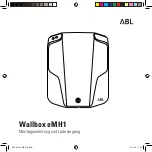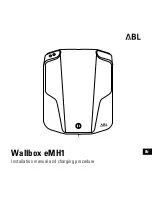
Thank you for choosing this quality Griot's product. The Battery Manager
V features state-of-the-art technology to improve battery performance,
longevity, and overall condition. Please read and understand all
instructions before using the Battery Manager V. Enjoy the best!
SAFETY PRECAUTIONS
Warning: Read these instructions completely before using the Battery
Manager V and save them for future reference. Before using the Battery
Manager V to charge a battery, read these instructions and the instruction
manual/safety information provided by the car, truck, boat or equipment
manufacturer. Following all manufacturers’ instructions and safety proce-
dures will reduce the risk of accident.
Working around lead-acid batteries may be dangerous. Lead-acid batteries
release explosive gases during normal operation, charging and jump
starting. Carefully read and follow these instructions for safe use. Always
follow the specific instructions in this manual and on the Battery Manager
V each time you use the Battery Manager V. All lead-acid batteries (car,
truck and boat) produce hydrogen gas which may violently explode in
the presence of fire or sparks. Do not smoke, use matches or a cigarette
lighter while near batteries. Do not handle the battery while wearing
vinyl clothing because static electricity sparks are generated when vinyl
clothing is rubbed. Review all cautionary material on the Battery Manager
V and in the engine compartment.
Always wear eye protection, appropriate protective clothing and other
safety equipment when working near lead-acid batteries. Do not touch
eyes while working on or around lead-acid batteries. If battery acid
contacts skin or clothing, wash immediately with soap and water. If acid
enters eye, immediately flood eye with cold running water for at least 10
minutes and get medical attention immediately.
Always store clamps away from each other or common conductors.
Improper storage of clamps may cause the clamps to come in contact
with each other, or a common conductor, which would be hazardous if
the unit was plugged into an AC outlet.
Use extreme care while working within the engine compartment,
because moving parts may cause severe injury. Read and follow all safety
instructions published in the vehicle's Owner's Manual.
Batteries being charged with the Battery Manager V unit likely contain
liquid acids which are hazardous if spilled. Failure to follow instructions
may cause damage or explosion, always shield eyes. Read entire
instruction manual before use.
Warning: This product contains a chemical known to the State of
California to cause birth defects or other reproductive harm. Wash hands
after handling.
PREPARING TO CHARGE A BATTERY
1. If it is necessary to remove the battery from the vehicle to charge, always
remove the grounded terminal from the battery first. Make sure all
accessories in the vehicle are off, to avoid causing an arc.
2. Be sure the area around battery is well ventilated while battery is being
charged. Make sure there is no gasoline or other combustible material in
the vicinity.
3. Clean battery terminals with a mixture of baking soda and hot water. Be
careful to avoid corrosion coming in contact with eyes.
4. Add distilled water in each cell until battery acid reaches level specified
by battery manufacturer. This helps purge excessive gas from cells.
Do not overfill. For Maintenance-Free Batteries, carefully follow the
manufacturer's recharging instructions.
5. Study all battery manufacturer's specific precautions, i.e. - removing/not
removing cell caps while charging and recommended rates of charge.
6. Determine voltage of battery by referring to vehicle owner's manual and
make sure that charger output voltage matches.
LOCATING THE CHARGER
1. Locate the charger as far away from the battery as the cables permit.
2. Never place the charger directly above the battery being charged; gases
from the battery will corrode and damage the charger.
3. Never allow battery acid to drip on the charger when reading specific
gravity or filling the battery.
4. Do not operate the charger in a closed area or restrict ventilation in any
way.
5. Do not set a battery on top of the charger.
6. Locate the charger at least 18" above the floor.
7. Do not place the charger where rain, snow or other moisture could drip
on it.
CONNECTING TO BATTERY INSTALLED IN A VEHICLE
Caution: A marine (boat) battery must be removed and charged on
shore. To charge it onboard requires equipment specially
designed for marine use.
Caution: A spark near the battery may cause battery explosion. To
reduce this risk:
1. Position AC and DC cords to reduce risk of damage by hood, door or
moving engine part.
2. Stay clear of fan blades, belts, pulleys and other parts that can cause
injury to persons.
3. Check polarity of battery posts. POSITIVE (POS, P, +) battery post
usually has larger diameter than NEGATIVE (NEG, N, –) post.
4. Determine which post of battery is grounded (connected) to the
chassis. If the negative post is grounded to the chassis (as in most
vehicles), see instruction 5a. If the positive post is grounded to the
chassis, see instruction 5b.
5. a) For NEGATIVE GROUNDED vehicle, connect POSITIVE (Red) clip
from the battery charger to the POSITIVE (POS, P, +) ungrounded post
of the battery.
b) For POSITIVE GROUNDED vehicle, connect the NEGATIVE (Black)
clip from the battery charger to the NEGATIVE (NEG, N, –) ungrounded
post of the battery. (This arrangement is usually found in pre-1970
foreign vehicles or pre-1970 farm tractors. This is a rare occurrence.)
6. Connect the remaining battery charger clip to the vehicle chassis or
engine block, as far away from the battery as possible. Do not connect
the clip to carburetor, fuel lines or sheet metal body parts. Connect to a
heavy gauge metal part of the frame or engine block.
7. When disconnecting charger, turn charging sequence OFF by
depressing the "CHARGE" button, disconnect AC cord, remove clip from
vehicle chassis and remove clip from battery terminal.
8. Refer to the Operating Instructions for information on setting selector
switches.






















